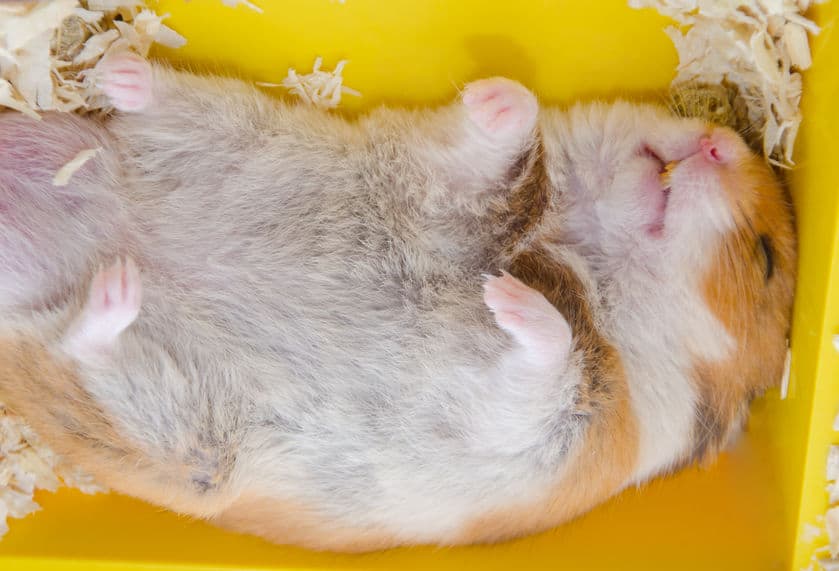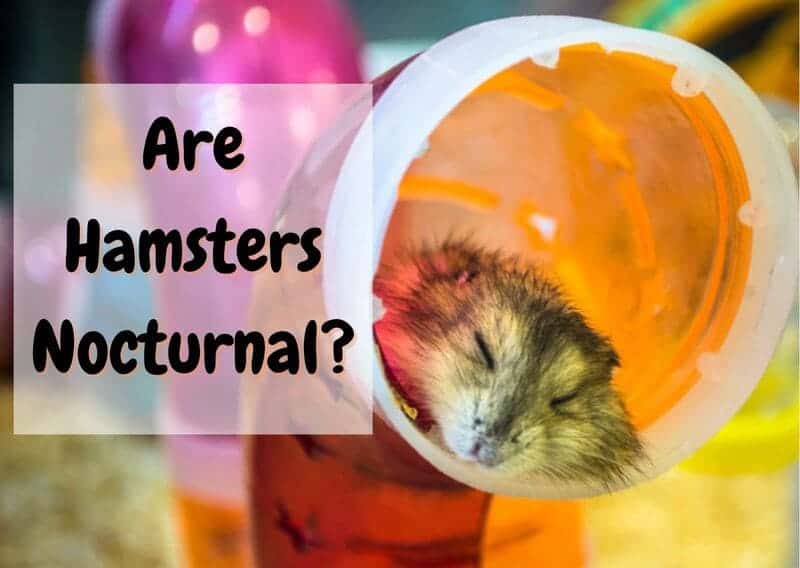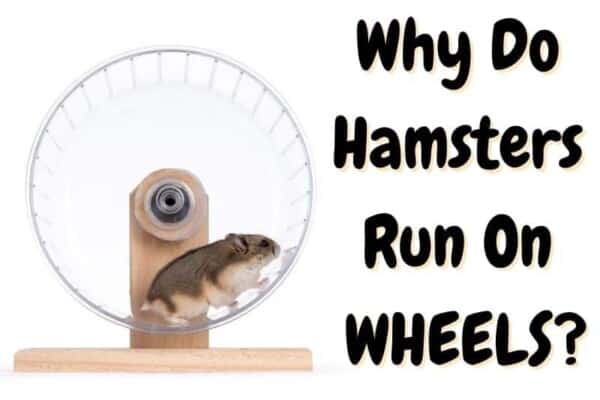Are hamsters nocturnal? These rodents seem nocturnal to the latent eye, but there is a type of sleep pattern that is unknown to the average pet owner. In this post, you will learn more about the hamster’s sleep pattern and also practical steps to make sure that your hamster gets an ideal amount of sleep every day. The good thing is, hamsters are not too fussy about their sleeping habits, as you will soon discover.
Are Hamsters Nocturnal?
Yes, Hamsters are considered nocturnal since they are most active at night and will rest during the day. However, they are technically crepuscular since they wake up before sunset to start their daily activities, like playing and foraging for food.
A normal cycle of sleep for a hamster is 6-8 hours during daylight hours. This will depend on the breed of hamster since not all types are equally following the same sleeping patterns.
It also depends on how much exercise they get per day, and how much sleep they require after that. Even dwarf hamsters have different sleep patterns since there is generally more than one per cage as opposed to solitary Syrian hamsters. All in all, among the different breeds, they all follow a reasonable pattern that is waking at dusk and sleeping at dawn.
Noises or sounds may wake up a hamster but they don’t make much of a fuss and usually go back to sleep fast. If they are alerted, they will remain awake for a bit, and when they see there is no threat, they go right back to sleep. They can make up for these disturbances by nodding off at night to counter their fatigue.
Practical steps for your hamster to sleep well
- Lighting: Keep the lighting nice and dim in the room in the daytime so they will feel they are undisturbed. They are not as sensitive as guinea pigs to noises, but lights do need to be dimmed when they are resting. They retreat to a sleeping area that’s nice and dim anyway. Don’t leave the light on during the day and close the blinds so they have a darkened room to rest.
- Food: A good diet is always a healthy way to ensure your hamster will sleep better. As long as they get a balanced diet with a good variety of goodies, they will have fewer sleep issues.
- Handling: A good amount of handling at night is recommended in addition to activities in their play area. Handling them when they are awake will also keep them familiar with you and make them less prone to nipping or biting.
- Excitement: Hamsters are curious about play zones, so making mazes and adding hamster tunnels will keep them busy. Tubes also provide a place where they can explore and eventually tire themselves out. You can also put them inside a hamster ball and let them roam around in your home.
Should I cover my hamster cage?
Don’t cover your cage at all because it may cause all sorts of problems. The first is an airflow circulation issue and it might make them warmer than necessary. The second is the issue of them chewing on a blanket which can be harmful to them by creating stomach blockage.
How do I make my hamsters sleep?

Keeping them active while they are awake is a good way to help tire them out. You can’t force them to sleep, so don’t expect you can train so easily. Just giving them two hours of handling per day will be sufficient to tire them out.
The rest is a matter of giving them an exercise wheel and activities inside their cage such as toys and hamster wheels and tunnels. If there is more than one inside a habitat, they will be social and play with one another. The rest of that time will be dedicated to typical behaviors such as snoozing, foraging, and exploring.
Where do hamsters like to sleep?
The funny part about hamsters is how creative they can get when it comes to sleeping inside their cage. Let’s explore what common items your hamster will enjoy sleeping in. This will give you some ideas as to the type of items you could add when you set up your hamster’s cage.
1. Hut
A hut is any kind of structure that has a cover. Even using half of a coconut shell with an entry door like an igloo is good. If you have an empty tissue box, you can cut a hole in the side and this will make a good hut for them. Be sure to remove any plastic liner that is on the box so they don’t chew on it.
2. House
You can have a house built out of edible wood or from a children’s shoe box. Don’t give them anything plastic because they might chew on it and ingest these pieces. Wood or ceramic is a good choice since these items will last a long time. If you work on a budget, then empty cardboard food containers will work wonderfully.
3. Inside toilet paper tube
Your hamster will love these left-over toilet paper tubes to play in and will even use them for resting. Because they can be chewed on, there is no danger if they destroy them. In one month of collecting these tubes, you will find all sorts of uses for them. If you glue them together, use a safe edible adhesive like Elmer’s glue.
4. Fleece Sock
Left-over socks made from fleece are another great place that hamsters like to sleep in. It’s a soft place that simulates a burrow, except these socks are nice and snuggly. Don’t be surprised if they add grass and bedding inside to make it extra cozy.
You will need to clean these socks at least once a week because of urine or poop. You can find lots of these at second-hand stores or from the dollar store on clearance.
5. Under a fleece blanket
A little fleece blanket is a fun hidey spot that can instantly become a sleeping retreat. You can scrunch it up so they can find nooks to crawl into. They may enjoy crawling underneath one edge and poking their head or little nose out.
Once again you will need to clean this blanket once a week so it does not start to smell. This will keep your hamster smelling cleaner too.
What position do hamsters normally sleep in?
Hamsters are little creatures that have a lot of tolerance to sleep in all sorts of positions. It can have everything to do with the temperature or simply where it is comfortable. They will surprise you with how relaxed they can be when it comes to snoozing at any time of the day. Here is a list of positions that you will see more often:
- On their stomach
- On their side
- On their back
- Curled up
- Head hanging out
- Smushed-up/crashed
- Arms and legs everywhere
What is normal hamster sleep behavior?
- Snoring: It won’t be uncommon to hear them snoring at times of the day. It’s not the loudest sound in the world and often will sound like rubber squeaks from a tiny balloon.
- Squeaking: Hamsters do dream and often they will make the same noises they do when they’re awake. If your hamster squeaks softly in its sleep, it’s most likely a dream or nightmare.
- Legs kicking or running: If you’ve ever seen a dog or cat dream, you know they can move their legs as if they are running. Hamsters do the same, and it’s nothing to worry about.
A word of caution: clicking and wheezing
Your hamster might be getting sick if they make clicking noises while they sleep, which is audible noise from their lungs. This will also be followed by wheezing that could be from a respiratory problem. A visit to the vet is in order at that point.
Can you change a hamster’s sleep pattern?
It’s possible to adjust very slightly the sleep pattern of your hamster so that it will be able to interact more with you or your children. We do not recommend drastically trying to change a hamster’s sleep pattern since they settle into a hard-wired routine. If you try to change their pattern an hour or two earlier than they are used to, you must do it casually.
This means raising the lights to a soft glow in their room and softly talking to them. Offer their food as a training tool so they may be more enticed to wake up earlier. If they do adapt to waking up earlier, it will be from being consistent and patient over time.
Why is my hamster sleeping all the time?
There can be several reasons why your hamster is sleeping a lot that doesn’t relate to immediate health issues. It can simply be the temperature of the room. If the room is too warm or too cold, they will react by retreating to a cooler or warmer place.
It may also relate to the age of your hamster, especially if they are younger since they can sleep up to 10 hours on a perfectly normal day. If your adult hamster is doing this, it might be from something wrong.
This is when you need to consider taking them to a vet for a checkup. If they sleep more than 10 hours a day, it could be a sign of a malnourished diet. They also might have ingested something that is making them act this way.
What are some good hamster sleep accessories?
Hamsters like little burrows they find safety within. Some of the best habitats can house a whole group of hamsters, like several huts that are stacked on top of each other. Use bits of cardboard as ramps gluing them together with Elmer’s glue.
If you buy hammocks or other sleep accessories from online sources, these might get chewed and will need to be replaced regularly. You may do them yourself by using cardboard, coconut shells, wood, and other bio-degradable materials. When they are worn out, just replace them with new shelters.
Contents
- Are Hamsters Nocturnal?
- Practical steps for your hamster to sleep well
- How do I make my hamsters sleep?
- Where do hamsters like to sleep?
- What position do hamsters normally sleep in?
- What is normal hamster sleep behavior?
- Can you change a hamster’s sleep pattern?
- Why is my hamster sleeping all the time?
- What are some good hamster sleep accessories?













